The Beat’s Gregory Paul Silber has been accused of having a bit of an… obsessive personality. Each week in Silber Linings, he takes a humorous look at the weirdest, funniest, and most obscure bits of comics and pop culture that he can’t get out of his head.
Starting with its debut issue in 2011, Ultimate Comics: Spider-Man was the first comic I ever followed month-to-month. I came for the promise of a new, Afro-Latino Spider-Man named Miles Morales, but stayed because it was just a damn fine superhero comic thanks to writer Brian Michael Bendis, penciler Sara Pichelli, colorist Justin Ponsor, and letterer Cory Petit. I had read a number of superhero comics before that, but very few from the 21st century; I cut my teeth on “essential” ’80s comics like Watchmen and The Dark Knight Returns. Reading a truly contemporary comic for the first time, I was intrigued by the creative team’s willingness to take their time in storytelling. I don’t think Miles appeared in costume on panel until the end of the third issue.
I understand why it may seem odd to some people, but I truly didn’t mind the relative lack of superhero action in that comic ostensibly about Spider-Man. I was more used to reading prose novels than comics. I don’t necessarily mind if the adventure doesn’t begin until a few chapters into a fantasy novel, and I didn’t mind that this Spider-Man series was paced more like a novel than the handful of Silver Age issues I read. I enjoyed getting to know Miles, his friends, and his family. Once he did become Spider-Man, his fights with the Prowler carried more weight, because Miles’ character felt more lived-in.
I would later find out, with some puzzlement, that Brian Michael Bendis was a somewhat divisive writer for many of the same reasons that I enjoyed his work. Among other quibbles, the biggest complaint seemed to be that he was blamed for a trend in comic book writing known as decompression.

For those unaware, basically what that means is that whereas a single “floppy” comic book issue would tell a more-or-less complete story (or multiple stories!) within 20-odd pages, Bendis popularized the practice of “writing for the trade.” So for a majority of comics of the past 20-years or so, you’re only going to get the complete story if you read the roughly 4-6 issues that typically are compiled for a glossy hardcover or trade paperback that can be sold on bookstore shelves. Comics had been telling multi-issue sagas at least as long as the early Marvel days, but typically, a single issue would still have a distinct beginning, middle, and end of its own even while adding to a larger tapestry. Comics are rarely structured like that anymore.
Despite the premise of this essay, I want to be clear that I understand where the frustration comes from. Having to pick up multiple issues for a single story isn’t just unwieldy (especially for readers who aren’t familiar with the draconian practices of the direct market), but expensive. Besides, decompressed storytelling sometimes means that a single issue can be read in as little as five minutes. That’s practically a dollar per minute of entertainment.
Plus, obviously some comics (and creators) do decompression better than others. Oftentimes, after finishing a comic from my monthly stack, I almost immediately forget what happened in it because the story was stretched so thin. And sure, I’ve often described myself as a “Bendis apologist,” but I’ll be the first to admit he’s written his share of stinkers. You would, too, if you wrote like eight comics a month (conservative estimate) for two decades.
But the other side of that coin, that few old-school comic book readers are willing to admit, is that the hyper-compression of pre-Bendis comics, especially in the gold and silver ages, had its own set of problems. Storytelling needs room to breathe. There’s no shortage of comics I love from decades past, and many older creators deftly maneuvered the challenges of telling satisfying, dense stories in two dozen pages or less. But surely I can’t be the only one who thinks the conventions of 20th century comic book storytelling led to a lot of stories that read as rushed in the telling. Not all of them, of course, but many read more like summaries than actual stories.

Case-in-point, brace yourselves for what’s probably my single hottest take about comics: pound-for-pound, the retelling of Peter Parker’s origin story by Bendis and artist Mark Bagley in 2000-2001’s Ultimate Spider-Man volume 1 is more satisfying than the original origin as told by Stan Lee and Steve Ditko in 1962’s Amazing Fantasy #15.
Stop yelling at me! I can explain!
Obviously, I’m not saying Ultimate Spider-Man comes close to matching the historical importance of that initial Amazing Spider-Man run. I love Spider-Man, and it’s not like he wasn’t great until Bendis and Bagley came along decades later. Nor am I saying that Bagley is a better artist than Ditko was… although, considering all the evidence that Lee didn’t do nearly as much “writing” as he gets credit for, I wouldn’t be opposed to arguing in favor of Bendis as the better writer.
Stop! Yelling! At! Me!
Seriously though, as entertaining as those initial 11 Spidey pages are as a glimpse into their era, and as much as we can appreciate Amazing Fantasy #15 for introducing us to quite possibly the single greatest superhero of all time, things happen so quickly that it hardly reads like a story. I’ve heard many comics boomers wax nostalgic about how remarkable it is that so much happened in those 11 iconic pages, and while that may be impressive in its own way, I don’t subscribe to the notion that brevity is inherently a virtue. Not to sound like your high school English teacher, but I prefer more of a “show don’t tell” approach. Lee and Ditko were able to squeeze in as much as they did in so few pages because “telling” generally takes less time, and in the case of comics, less physical real estate.
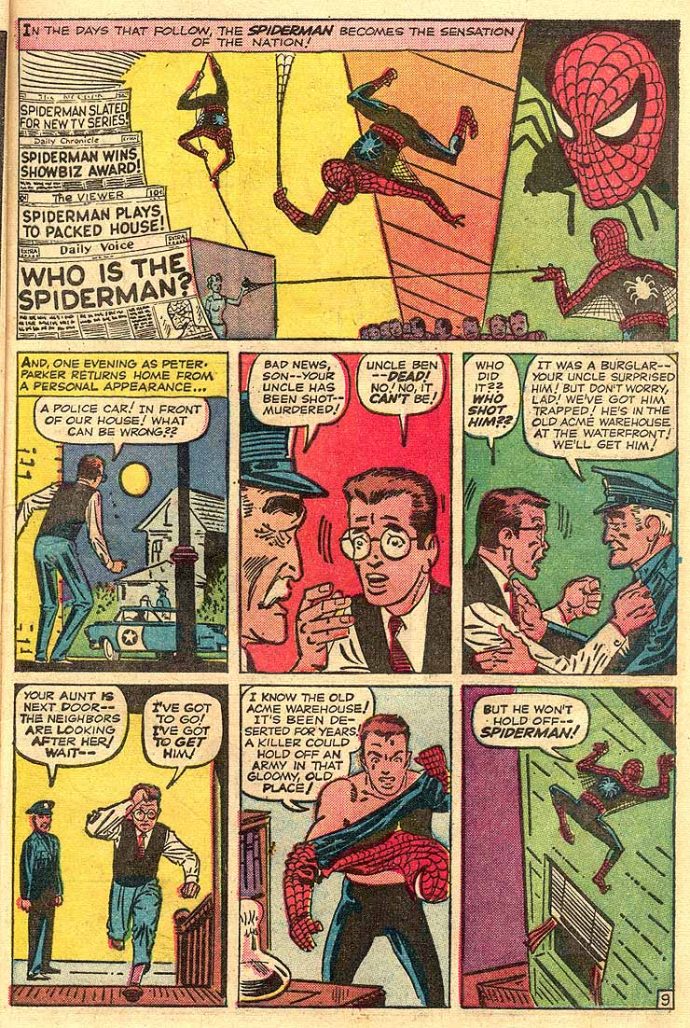
Ultimate Spider-Man volume 1, on the other hand, thrives on “showing.” By the time Uncle Ben dies at the end, it carries more emotional weight because we got a better sense of who he is and what was special about his relationship with his nephew.
Even if you disagree with me about the written side of decompression, I think it’s harder to argue against the notion that it’s benefited comic book art. This may sound overly simplistic, but with a tendency toward fewer panels per page, and fewer words filling up each of those panels, artists have more room to spread their wings.*
(*Ed. Note: Bendis is also fairly well-known for pages chock-full of panels and word balloons. Decompression comes in all shapes and sizes. –JG)
Plus, I should acknowledge that Bendis hardly invented decompression. Chris Claremont comics of the ’70s and ’80s are less compressed than Lee’s, for example, and if you trace the styles of influential comic book writers that followed, you’ll find that comics were progressively getting less compressed for decades before Bendis. When you read the work of ’80s and ’90s comic book writers like Frank Miller, Alan Moore, Neil Gaiman, Mark Waid, and Christopher Priest, it becomes clear that an era of comic book creation was defined by its willingness to being less beholden to traditional conventions of comic book writing, and opening up more to influences from prose novels, television, film, theater, and perhaps even the snappy rhythms of standup comedy.
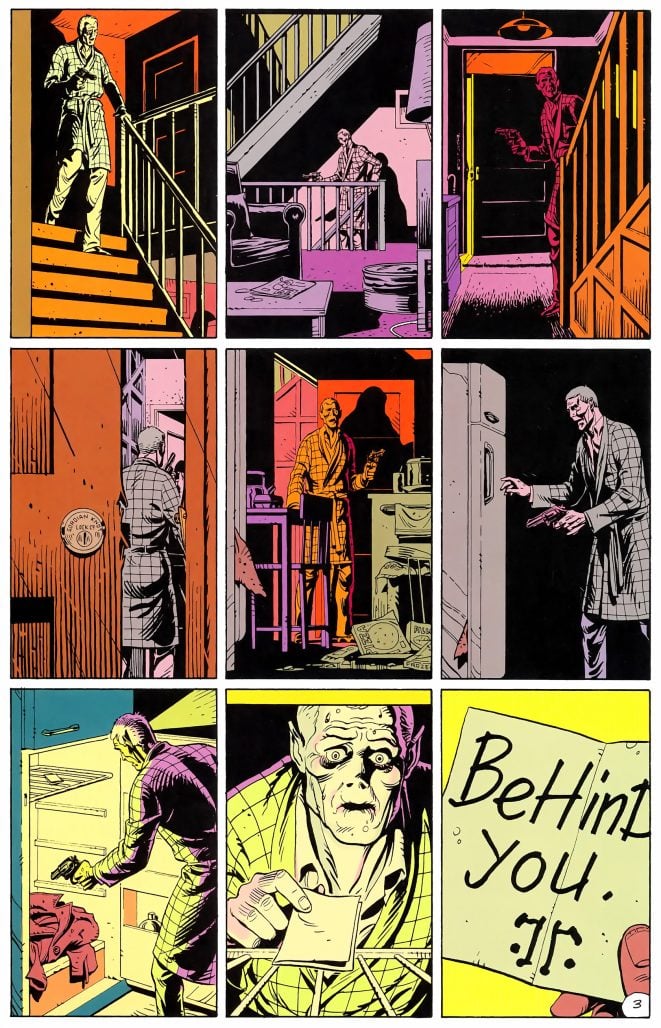
The influence of decompression goes beyond just superhero comics, by the way. I don’t think a comic like Saga would exist if Fiona Staples was expected to draw six panels or more per page, every page, or if Brian K. Vaughan was expected to write like Roy Thomas. That’s a comic that thrives on taking it’s sweet time letting us get a handle on all its characters and relationships, and having the patience to make its universe feel lived-in.
You may disagree with me on the particulars, but I would challenge longtime comic book readers to consider the notion that, viewed through a broad lens, decompression has largely been healthy for comic book storytelling. The gift of decompression is that comic book stories can take as long as they need to play out effectively. It’s been abused, sure. But it’s just another tool in the comic book creator’s tool kit. Here’s to using it wisely.




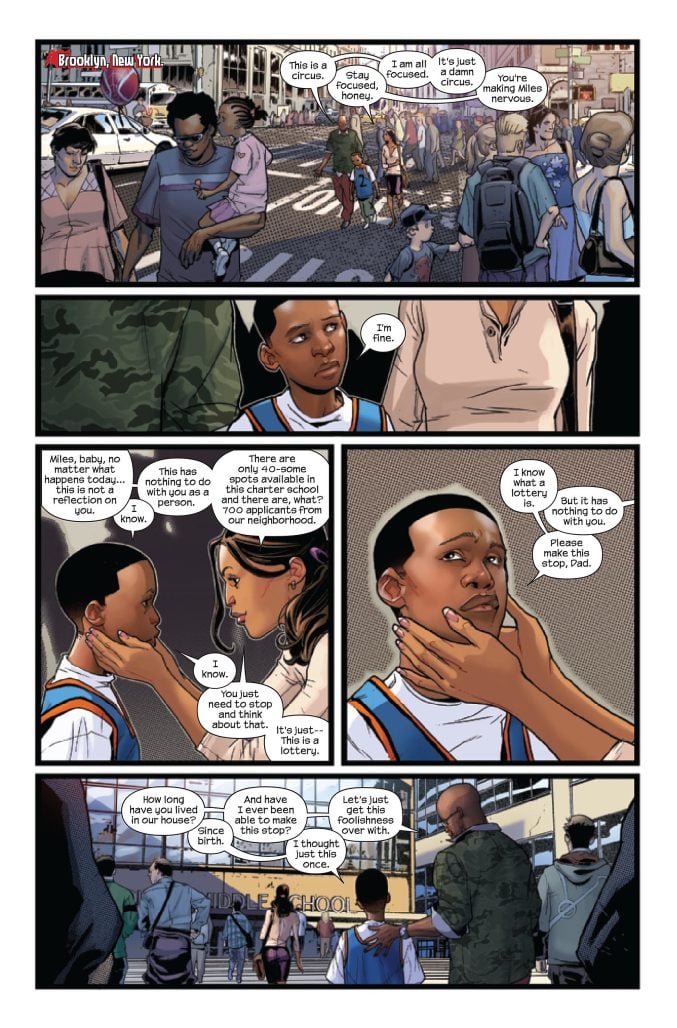


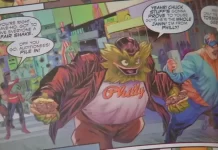





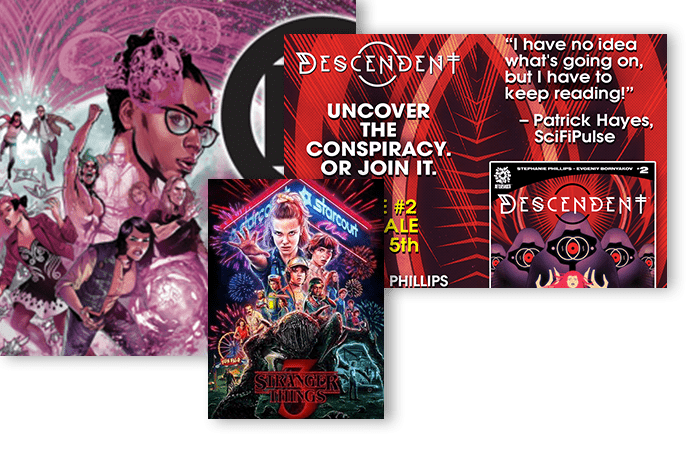
The challenge with decompression relates to entertainment value: those Amazing Spider-Man issues in the 1960s took twenty minutes to read versus six or seven minutes for the series forty years later, according to a study I once did. Not every wordy issue is good, of course, but the “satisfying chunk” of story does seem to be what consumers want to see, no matter how many words appear.
I think the real danger of decompression is indie creators thinking that showing these details necessarily makes for a better story. Big comics and manga publishers can afford to commit to longer-form serials; a solo creator working on a pet project in his free time would do well to learn how to tell a compelling story in 16 pages, rather than shoot for that sprawling epic.
Okay I’ll say it, decompression is just bad storytelling for BOTH writing and art. Comparing Bendis Spider-Man to Lee-Ditko is fallacious and dishonest. Cramming a full story in 8 to 12 pages in the Golden/Silver Age was just good value for money and had no pretension to be other than disposable. And self-contained. Why today would we sell a monthly separate book that only contains a chapter of a multi-part arc. That is just nonsense from a long-term sales perspective and from a storytelling standpoint. If you are not able to see that the arrival of Bendis, Waid, Morrison, etc on the scene is when comics jumped the shark, then you’re deluding yourself. And I’ll address the question of the art as well. Comics used to be dynamic storytelling. It is no more. Today we see nothing more than a collection of stiff pinups from most of the ‘hot’ artists. I challenge you to read the first volume of Naomi or Far Sector and figure out what is happening during the action scenes. If Bendis and al want to write that kind of stories, why don’t they write proper books without pictures.
When I want good storytelling, I read LOSH by Levitz and Giffen, Teen Titans by Wolfman and Perez, Byrne’s FF or Superman, Pérez’ Wonder Woman, Simonson’s Thor. After those, the Image era begins and I had to stop reading mainstream comics because I couldn’t make heads or tails of those endless ‘to be continued’ events that you seem to enjoy so much. Sorry, but no.
It takes some guts to try to pass of (even one page of) Watchmen as an example of decompression…. That ain’t decompression, that’s good storytelling fitting for this particular scene. If Alan & Dave had kept that up, they would still be busy working on Watchmen, and it would have been a VERY BORING READ! I sort of get what Silber is driving at, but he picks his examples poorly. If I have to pick a comic that used to be ‘hot’ but had aged very badly, Ultimate Spider-man is one of the first comics that comes to mind.
I should probably clarify that when I say Ultimate Spider-man hasn’t aged well, it is the first series that I have in mind. That’s wat I cannot agree with Silber’s conclusion after his comparisson of Ultimate Spider-man #1 with Amazing Fantasy #15, his conclusion being that Ultimate Spider-man #1 is the superior comic. I did not mean to say I found Miles Morales’ first introduction to have aged badly. Because this introduction also occured in (later issues of) Ultimate Spider-man, I thought it appropriate to clarify. Even though I wouldn’t consider this introduction to be superior to Amazing Fantasy #15 either, I do understand the positive points Silber is trying to point out about the way this introduction is being played out in the first issues, and how this might be considered to be more ‘realistic’.
“decompression has largely been healthy for comic book storytelling.”
No, it hasn’t. And I’m not surprised an adult who only started reading monthly comics in 2011 doesn’t understand this.
Comics books aren’t comic books with decompression. They’re storyboards. And while the art under decompression may have gotten prettier, the storytelling has fallen off a cliff. Take the words out of a comic written 30 years ago and you’ll still likely understand everything going on. Take the words out of the average decompressed comic and you’ll have no idea what you’re looking at.
Mike
Comments are closed.